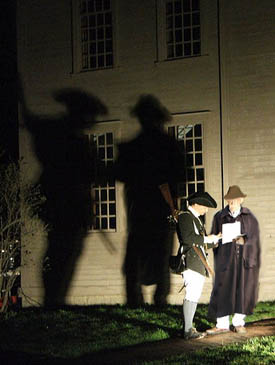Paul Revere's Midnight Ride
In 1774 Revere took a new responsibility as a rider for the Massachusetts Committee of Correspondence. He stayed in Boston taking care of his silversmith business and participating as an active leader of the “mechanics” group. The group of “mechanics” consisted of 30 men who gathered information about the moves of the British and joined every week in a tavern in North End to share information. Revere is credited by the Central Intelligence Agency as the creator of the first Patriot intelligence network on record. In the Spring of 1775 the “mechanics” became suspicious when they detected British vessels being prepared to cross the river. Paul immediately reported their findings to Dr. Joseph Warren.
Dr. Joseph Warren was the temporary leader of the Massachusetts Provincial Congress in Boston. Samuel Adams and John Hancock, the Congress leaders, were wanted by the British and were hiding and conducting business from a place of safety in the outskirts of Boston.
 On Sunday April 16, Dr. Joseph Warren sent Revere to Lexington to warn John Hancock and Samuel Adams of the possibility of their arrest and to Concord to alert the population and the militia that they were coming to disarm them. On Sunday April 16, Dr. Joseph Warren sent Revere to Lexington to warn John Hancock and Samuel Adams of the possibility of their arrest and to Concord to alert the population and the militia that they were coming to disarm them.
They had to figure out the fastest way to alert the Patriots that the British were on the march and on his way back to Boston he stopped in Charlestown. He met Colonel Conant of the Charlestown Committee of Safety and together they set up a plan to place signals in the tower of the Old North Church in the North End. The tower of the Old North Church was the highest point across the Charles river so the signal would be visible on a clear day. The signals sent to the Patriots would give advanced notice about the route the British were taking to reach Concord. They would hang one lantern if they were moving by land over the Boston Neck or two lanterns if they were crossing the Charles River by boat. The plan was all set and ready for execution.
Back home in Boston, two days later on April 18, Revere and the “mechanics’ were told that the British were preparing their boats to cross the Charles that night. They immediately reported to Dr. Warren. Paul Revere was to take the horseback ride that immortalized him.
On the same day at about 10 pm, Dr. Warren sent Revere and William Dawes, a shoe maker, to Lexington where Adams and Hancock were staying. They took separate routes in case one of them was arrested; they had to make sure the message would get to its destination. Dawes was sent through land while Revere embarked through the Charles River. As he was getting ready to board, he realized that the oars would make too much noise and would alert the British. Finally a boatman provided him with a petticoat from his girlfriend which he wrapped around the oars to muffle the sound.
Paul landed near Charlestown Battery where he had a horse waiting for him. When he was approaching Charlestown Common he was almost captured but he narrowly escaped. He arrived in Lexington and inquired the whereabouts of Adams and Hancock. He found them at the home of Jonas Clack where he personally delivered the note written by Dr. Warren. Soon after, Hancock and Adams fled to Woburn.
Now that the leaders of the Massachusetts Provincial Congress were alerted they had to head to Concord to alert the militia. Dawes arrived in Lexington about half an hour after Paul, they were joined by Samuel Prescott who was a resident of Concord and knew his way around the countryside. Together they set off for Concord.
The Redcoats had set temporary roadblocks as a security measure and on their way to Concord they encountered British soldiers. Prescott managed to escape; Revere was captured and Dawes tried to run away but was arrested shortly thereafter. The British held Revere and interrogated him with a pistol on his chest. He was asked about the plans of the militia and where they kept their ammunition. When asked where the Patriots were hiding he told them the truth and replied that they had 500 militiamen in Concord protecting them and 1500 coming. As they rode towards Concord he was told that if he tried to escape he would be shot.
Half a mile before they reached the Meeting House they heard guns being fired, the British apparently believed what Revere had told them in the interrogation and fearing for their lives released him. They took his horse and gave him a tired one.
Revere met Adams and Hancock on their way to Woburn but was sent back to Buckman's Tavern in Lexington where Hancock had forgotten some important papers concerning the Provincial Congress. He could still hear shots being fired; little did he know that gunfire at Lexington Green was the beginning of the War of Independence.
|